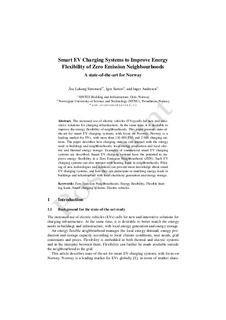| dc.contributor.author | Sørensen, Åse Lekang | |
| dc.contributor.author | Sartori, Igor | |
| dc.contributor.author | Andresen, Inger | |
| dc.date.accessioned | 2019-04-10T12:30:07Z | |
| dc.date.available | 2019-04-10T12:30:07Z | |
| dc.date.created | 2018-12-18T14:38:08Z | |
| dc.date.issued | 2019 | |
| dc.identifier.isbn | 978-3-030-00662-4 | |
| dc.identifier.uri | http://hdl.handle.net/11250/2594064 | |
| dc.description.abstract | The increased use of electric vehicles (EVs) calls for new and innovative solutions for charging infrastructure. At the same time, it is desirable to improve the energy flexibility of neighbourhoods. This paper presents state-of-the-art for smart EV charging systems, with focus on Norway. Norway is a leading market for EVs, with more than 110,000 EVs and 2000 charging stations. The paper describes how charging stations can interact with the energy need in buildings and neighbourhoods, local energy production and local electric and thermal energy storage. Examples of commercial smart EV charging systems are described. Smart EV charging systems have the potential to improve energy flexibility in a Zero Emission Neighbourhood (ZEN). Such EV charging systems can also interact with heating loads in neighbourhoods. Piloting of new technologies and solutions can provide more knowledge about smart EV charging systems, and how they can participate in matching energy loads in buildings and infrastructure with local electricity generation and energy storage. | nb_NO |
| dc.language.iso | eng | nb_NO |
| dc.relation.ispartof | Cold Climate HVAC 2018 - Sustainable Buildings in Cold Climates | |
| dc.title | Smart EV Charging Systems to Improve Energy Flexibility of Zero Emission Neighbourhoods | nb_NO |
| dc.type | Chapter | nb_NO |
| dc.description.version | acceptedVersion | nb_NO |
| dc.source.pagenumber | 467-478 | nb_NO |
| dc.identifier.doi | https://doi.org/10.1007/978-3-030-00662-4_39 | |
| dc.identifier.cristin | 1645031 | |
| dc.relation.project | Norges forskningsråd: 701703 | nb_NO |
| dc.relation.project | Norges forskningsråd: 257660 | nb_NO |
| dc.description.localcode | This is a post-peer-review, pre-copyedit version of a chapter published in Cold Climate HVAC 2018 - Sustainable Buildings in Cold Climates. Locked until 12.12.2019 due to copyright restrictions. The final authenticated version is available online at: https://doi.org/10.1007/978-3-030-00662-4_39 | nb_NO |
| cristin.unitcode | 194,0,0,0 | |
| cristin.unitname | Norges teknisk-naturvitenskapelige universitet | |
| cristin.ispublished | true | |
| cristin.fulltext | postprint | |
| cristin.qualitycode | 1 | |
